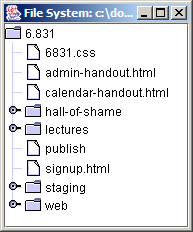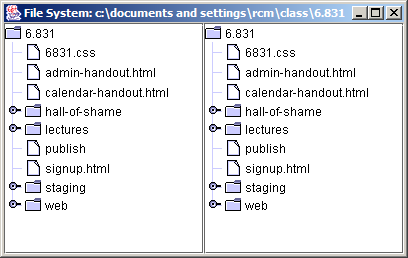6.831 User Interface Design & Implementation
Fall 2004
PS1: Model-View-Controller
Due 5 pm, Friday, September 24, 2004, by email
This assignment explores the following topics:
- the model-view-controller paradigm as it is implemented in a
particular Swing widget, JTree;
- sending events between model and view/controller;
- data-bound widgets.
In this problem set, you will implement a user interface that displays
a subtree of the filesystem, and allows the user to rename files.
Provided Resources
We provide you with the following:
Feel free to change this class as you see fit, or even replace it
entirely.
Problem 1: Static Tree
When you compile and run the FileSystem class we provide you, you'll
see that it prints the names of all files in the current directory and
its subdirectories, recursively. If you specify a different
directory on the command line, it displays that directory instead.
Modify this program so that instead of printing filenames to the
console, it displays them in a JTree widget. For now, just use
the JTree's built-in model to do this: DefaultTreeModel and
DefaultMutableTreeNode.
The resulting window should look something like this:

Only the top-level directory should be expanded initially (JTree's
default behavior). Obviously, make sure the window can scroll if
the tree is too large for it.
Problem 2: Data-Bound Tree
The approach you took in problem 1 doesn't scale well. Try
pointing it
at a deep subtree (C:\Windows is a good choice on Windows
platforms;
/usr works on Unix platforms). What happens?
The solution to this
problem, sometimes called data
binding, is to connect the tree widget directly to a live
filesystem model, instead of a copy of the model.
Modify FileSystem so that it can handle deep subtrees without
noticeable delay. It should scan the filesystem lazily, fetching a directory's
contents only when those contents are actually needed. There are
two approaches to doing this with JTree: (1) implement your own
TreeModel; or (2) use DefaultTreeModel, but implement your own
TreeNodes.
Note that lazy loading doesn't mean that the model is changing, only that it doesn't
bother creating parts of itself until a client actually looks at those
parts. You don't need a background thread for lazy loading, and
the model shouldn't be sending events to its listeners as it builds
itself lazily.
Your interface should still look like it did in problem 1.
Problem 3: Mutable Model
Until now, your filesystem model has been immutable: it never changed while
the JTree was displaying it. Now we'll make it mutable.
Modify FileSystem so that it displays two JTree widgets side-by-side,
both pointing to the same model:

Make both JTree widgets editable (hint: JTree.setEditable()).
In an editable JTree, you can edit the label of any file or directory
by triple-clicking (yikes!) or pressing F2:

When the user edits a label in a JTree and presses Enter, your program
should respond by renaming the corresponding file in the
filesystem. Since both JTrees have the same model, both JTrees
should then reflect the renamed file:

Making this work depends on which approach you chose in Problem 2:
- If you implemented your own TreeModel, then you will need to
implement TreeModel.valueForPathChanged()
to handle the user's edits, and you will need to broadcast a treeNodesChanged
event to your listeners. It's a little tricky to set up the TreeModelEvent
object that you pass along to treeNodesChanged. The
TreeModelEvent should describe the node that changed by giving the path
to the changed node's parent
(not to the changed node itself!), plus the index of the changed node
among its siblings.
- If you implemented your own TreeNode, you need to implement MutableTreeNode
instead, and implement setUserObject to handle the user's edits.
If you did it this way, then the DefaultTreeModel takes care of
managing listeners and broadcasting events to them.
Questions
Answer the following questions in readme.txt.
- Point FileSystem at a directory that's too long to fit in the
window, so that scrollbars appear. Which parts of the model does
JTree have to request in order to display the window initially?
(Don't just guess: find out.) Why does it do that?
- Does your filesystem model cache the directories it looks at, or
does it access the filesystem whenever the model is accessed? What
are the advantages and disadvantages of caching?
- Your filesystem model is not fully data-bound. What
filesystem changes does it fail to notice? How might you fix that?
What to Hand In
Package your completed assignment as a jar file. Your jar file
must contain:
- Class files. Compiled
class files for your program.
- Source files. All Java
source files you wrote.
- Resources. All the
resources your code needs to run. For example, the words file must be included in
your jar file;
so should any images or other data files your code requires. All
resources of this kind should accessed with Class.getResource().
Your code shouldn't have any absolute
filenames in it, since they're not likely to work on our machines.
- Readme. A plain
text file called readme.txt
that answers the questions we asked in this
assignment, if any.
- Manifest. Your jar
file's manifest file must include a Main-Class
parameter that specifies the main class, so that we can run your jar
using java -jar yourfile.jar
The Java tutorial has a section
about jar files that explains how to create a jar file and define
its manifest file. If
you're using Eclipse, you can create a jar file from your project using
File/Export. The Export wizard offers options for including
source files, readme and other resources, and specifying the Main-Class
for your jar's manifest.
If your program depends on any third-party libraries, you have two
choices:
- Unpack the other jars into class files, and include those class
files in your jar. This is the least-error-prone approach, and is
strongly recommended.
- Put a Class-Path
parameter in your jar's manifest file specifying the jar files it
depends on. For example:
Class-Path: TableLayout.jar xerces.jar
Then hand in TableLayout.jar and xerces.jar alongside your own jar
file. This is error-prone because you might forget to send us a
required jar file.
Before you submit your solution, put all the jar files you plan to
submit in an empty directory and make sure you can run it:
java
-jar yourfile.jar
Submit your solution by email
(with
all required jar files attached) to rcm+handin@graphics.csail.mit.edu
no later than 5:00 pm next Friday.



